As an Amazon Associate, I earn from qualifying purchases with no additional costs for you.
Cleavage is one of the vital properties of minerals needed for mineral identification. It is significant because the correct interpretation of cleavage observed gives you a clue to the inner atomic structure of minerals.
To test cleavage, observe reflective surfaces left after breaking the mineral. Check whether it is one, two, three, or more cleavage directions. Assume how easily minerals can be split along cleavage planes and how even the surfaces left are. Describe it as perfect, good, poor, indistinct, or none.
Let us share impressions of first-time learning cleavage as a geology student. Imagine an exquisite woman coming to a classroom with a piece of rock. It is a very common scene in a geological faculty. And in a second, you are frightened by the loud noise of smashing rocks on the floor. We were shocked and scared. Professor asked us to gather ideal cubes of halite (a mineralogical name for salt) from the floor and to write down the topic of the lecture: Cleavage.
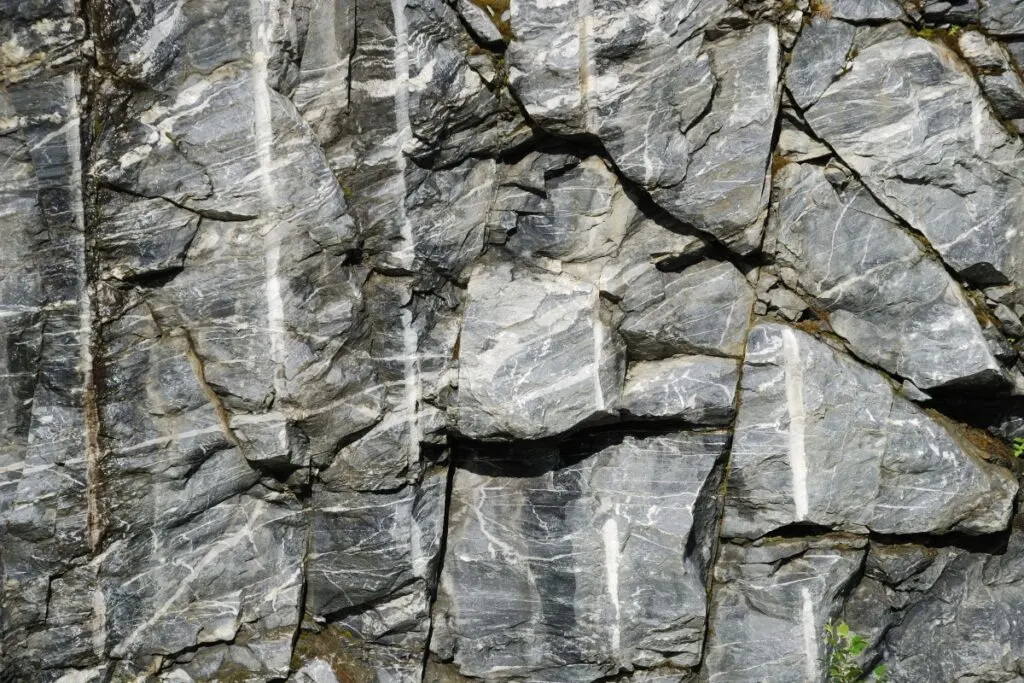
If you are interested in checking out the best books about rock and minerals identification you can find them by clicking here (Amazon link).
What is Cleavage in Minerals
Cleavage is one of the properties tested during mineral identification. It is vital for silicate minerals primarily, especially for amphiboles and pyroxenes.
Cleavage refers is a tendency of minerals to break along specific directions (cleavage planes), which corresponds to atomic weaknesses in the crystal structure. Depending on the number of directions, habits, and surface quality after the splitting, there are several categories of cleavage.
To understand the nature of cleavage, we have to go to an atomic level. Minerals are made of various atoms. These atoms can be combined differently. Therefore, distances between the atoms are different. If short and long atom bonds occur in one crystal, cleavage is likely to occur between long bonds.
You can see the atomic structure of graphite, composed of carbon atoms only. In one direction, atoms are bound with a strong covalent bond.
But perpendicularly, layers of carbons bonds are weaker and joined by weak Van der Waals bonds that can be easily broken. As a result, graphite has perfect cleavage in one direction (basal). This cleavage property makes graphite a good lubricant that found its application in many mechanisms.
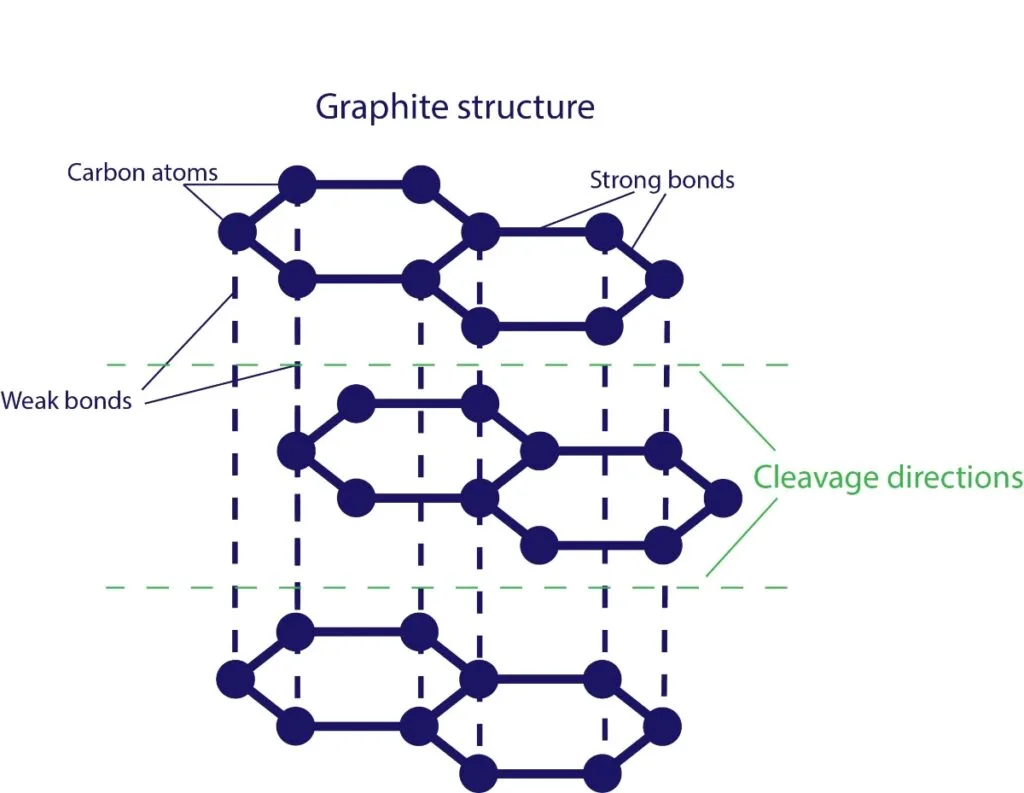
This dolomite sample is a perfect illustrative material for cleavage. You can see intersections at similar angles and smooth surfaces that signify cleavage planes.
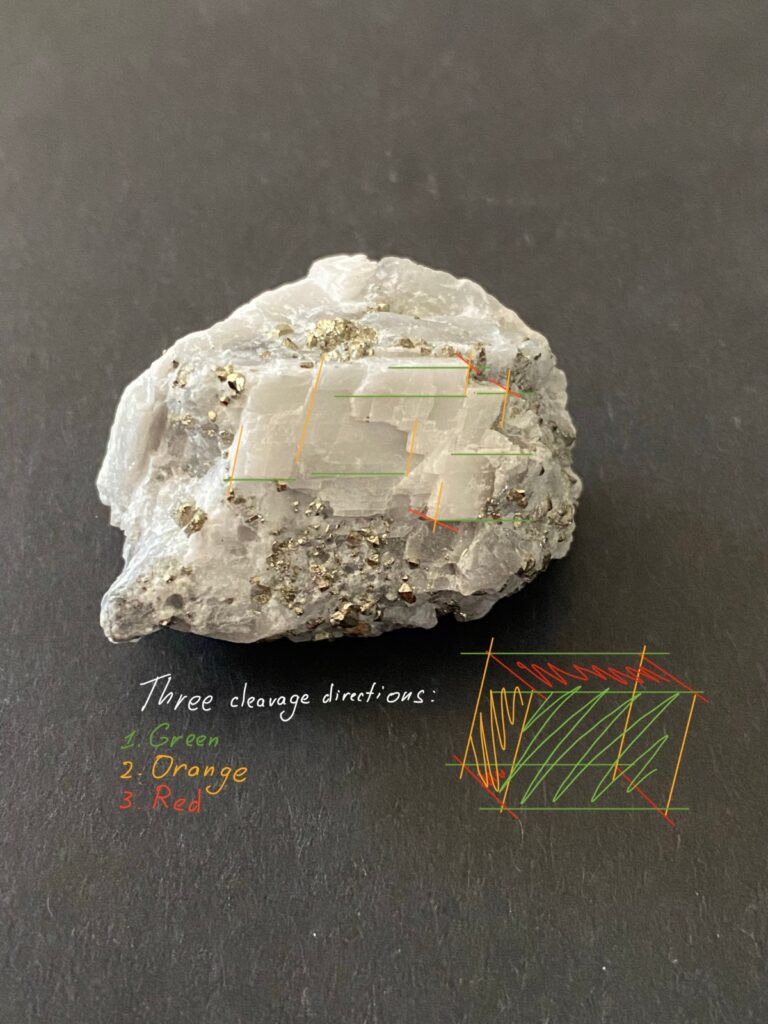
Why is Cleavage in Minerals Important
Cleavage in minerals is essential in various spheres. First of all, it can help with the identification of minerals we are concentrating on which here.
Also, cleavage is crucial while faceting gemstones. For example, before the saw invention, diamonds were split along cleavage planes only (yes, the hardest diamond also has cleavage – perfect in four directions).
The cleavage test helps to identify minerals. Cleavage reflects the unique inner atomic structure of minerals. The cleavage test is essential in differentiating amphiboles and pyroxenes, where other mineral properties are similar. Also, understanding cleavage helps in gemstone faceting and carving.
Cleavage is a traditional physical property used in mineral identification in hand specimens and microscopic examination of rock and minerals.
For example, the angles between the prismatic cleavage planes for the pyroxenes (88-92°) and the amphiboles (56-124°) let to differentiate between these mineral groups easily.
TIP: Rocks can explode when heated. What types of rock are prone to explode, and what types are relatively safe? Find out the answer in the article below:
21 Rocks What Explode & Won’t Explode When Heated (+ Why)
Do All Minerals Have Cleavage
Some minerals don’t have cleavage. It is described as none in minerals lacking cleavage and tends to fracture rather than split evenly. For example, quartz, garnets, and olivine don’t have cleavage and break in irregular patterns. Limonite, pyrite, chalcopyrite, hematite, and magnetite have no cleavage.
Minerals that don’t have cleavage have cleavage stated as ‘none’ in mineral identification tables or literature. Many sulfides and sulfosalts don’t have cleavage. Some other mineral properties like luster or streak can help you to identify them easily.
Types of Cleavage Minerals
Most people are confused when it is cleavage as it is commonly not clear why somebody uses comparatives like perfect, good, and poor, but others star counting directions, and third use cubic, rhombic and basal. So it is a different description of cleavage, and now we will explain how to combine them like a PRO!
Cleavage in minerals is usually described by three factors: quality of cleavage (perfect, good, poor, indistinct, none), number of sides exhibiting cleavage (one, two, three, and all directions), and cleavage habit (basal, cubic, octahedral, prismatic, pinacoidal, rhombohedral).
To identify the correct type of cleavage, three categories have to be taken into account:
Quality of cleavage
The quality of cleavage is evaluated as both ease of the mineral cleaves and the character of the exposed cleavage surface. The quality of cleavage is expressed as:
- Perfect. For minerals that cleave easily and create even smooth planes without rough surfaces.
- Good. Minerals also make smooth planes but with minor residual uneven surfaces.
- Poor. Rough surfaces are dominant.
- Indiscernible (Indistinct). Cleavage planes are hardly noticeable.
- None. The broken surface is fractured and irregular.
Sometimes you can notice synonyms like ‘perfect,’ ‘distinct,’ ‘difficult,’ ‘imperfect,’ or ‘indistinct’ to describe the quality of cleavage.
Number of sides exhibiting cleavage
The number of sides exhibiting cleavage is pretty straightforward to describe. Just count how many directions indicate cleavage planes. Sometimes minerals have more than one direction of atomic weakness, so there can be:
- One direction
- Two directions
- Three directions
- All directions
To describe the cleavage of minerals, combine two properties. For example, perfect cleavage in one direction is the correct muscovite cleavage description.
Cleavage habit
Additionally, geologists use cleavage habits to describe the form created by cleavage planes.
Cleavage habits are:
- Basal cleavage. Used to describe just one direction of cleavage present in minerals. Typical for micas, mostly.
- Prismatic cleavage. Describe two directions of cleavage. Here the angle between two cleavage planes is critical and allows us to differentiate between the pyroxene mineral group (88-92°angles between cleavage planes) and the amphibole (56-124°).
- Cubic cleavage. Three directions cleavage with all right angles between cleavage planes. It is characteristic of minerals of the isometric crystal system. Galena and halite are typical examples.
- Rhombohedral (rhombic) cleavage. Another three directions cleavage, but angles differ from 90 degrees. Perfectly visible on calcite.
Check the table below to see how the number of directions can be combined with cleavage habits and angles between cleavage planes. Again, there are mineral examples for your identification convenience.
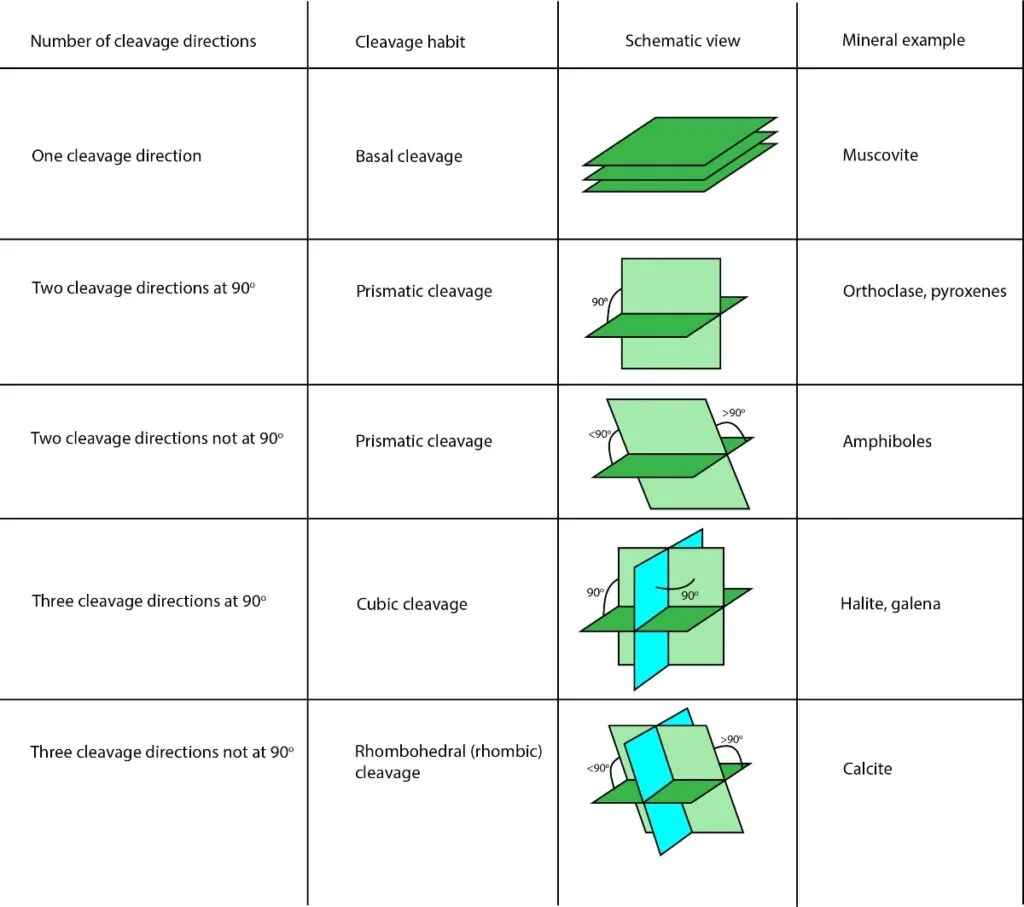
TIP: Minerals’ streak is one of the most important tests for mineral identification, especially while working with native metals and sulfide minerals. Check out the complete identification guide in the article below:
DIY Guide: Testing Mineral’s Streak (Explained by Expert)
How to Tell if a Mineral Has Cleavage
Mineral with cleavage shows very geometric habits. You will see many right angles, 90 degrees intersections, or intersections on other angles. Still, all the angles will be the same. Repetitive intersections, easy splitting of minerals, and reflective planes resulting from splitting signify cleavage.
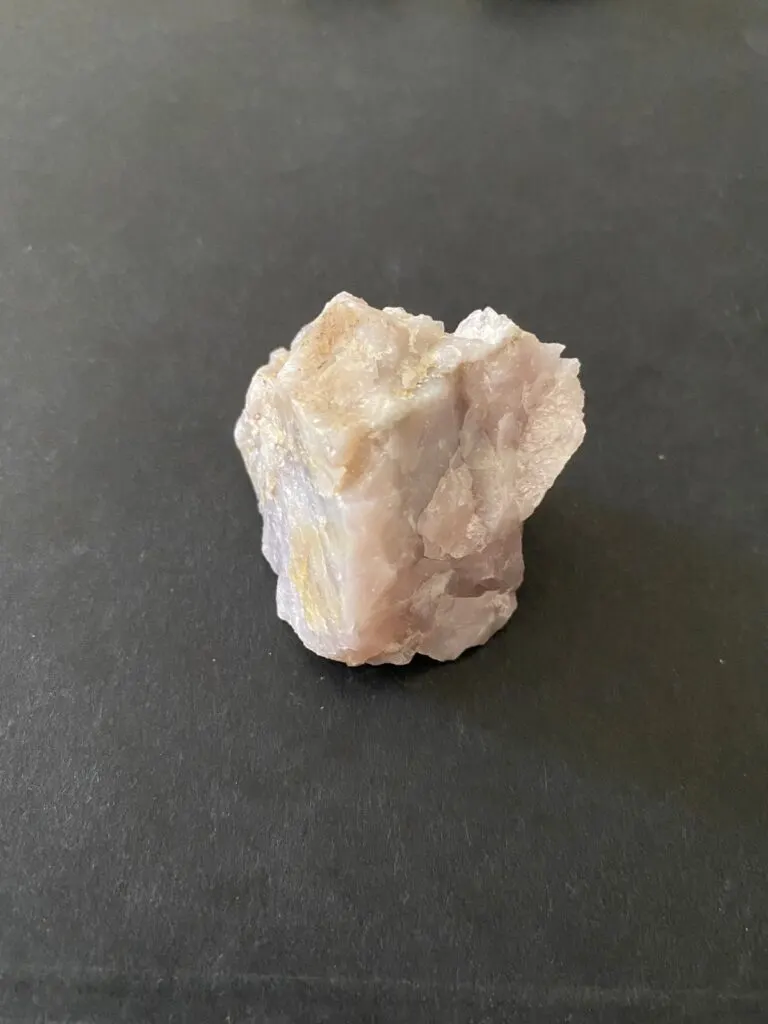
Here are pictures of minerals with no cleavage (quartz) and perfect cleavage in three directions (dolomite). You can clearly see that there are no smooth planes on the quartz, just rough, irregular fracture surfaces. At the same time, dolomite has a lot of intersections at similar angles and even surfaces.
BTW: Do you want to know more about rock and mineral identification? The books listed below are the best ones you can find on the internet (Amazon links):
- Smithsonian Handbooks: Rocks & Minerals
- Gemstone & Crystal Properties (Quick Study Home)
- Ultimate Explorer Field Guide: Rocks and Minerals (National Geographic Kids)
How to Test Cleavage of a Mineral
Testing mineral cleavage doesn’t require additional equipment. Careful observation can give you all information needed. The requirements are essential: good light, clean and dry sample.
To test cleavage, decide whether you see crystal faces or cleavage planes. Pay attention to the quality of cleavage planes, count cleavage direction, and assume angles between cleavage planes and cleavage habit. If you are unsure and can allow to break the sample, break it to find new cleavage planes.
Let’s proceed with cleavage identification according to step-by-step instructions.
Step 1. Preparation
The first step we always insist on is sample preparation and organizing the test environment. Most probably, you don’t start mineral identification directly with cleavage testing. Cleavage rarely tested the first.
Professional geologists commonly strat weather by hardness or luster. Check our step-by-step DIY Guide: Testing Mineral’s Hardness (Explained by Expert) or Performing Scratch Test on Rocks (Follow These 8 Steps).
Mineral samples have to be clean and dry. Avoid weathered surfaces for testing as they have different physical properties and can confuse you.
Commonly, mineral samples already exhibit cleavage planes, so there is no need to break them. Or it can be simply not allowed on samples from study collections for students.
Conduct cleavage tests in satisfying light conditions. It can be light from a window or lamp. Light is helpful to dee reflective surfaces.
Step 2. Differentiating between crystal faces and cleavage planes
It may seem confusing to differentiate between crystal faces and cleavage planes for the first time as they are both smooth and reflective. First of all, check the striation – parallel grooves on crystal faces.
Then, if you can break the sample, hit it with a hammer to create new cleavage planes. If there was a smooth surface and you observed uneven fracture and rough texture after the breakage – it was a crystal face initially.
Step 3. Deciding on the quality of cleavage
If there is at least one smooth reflective cleavage plane, judge its quality. The mirror-like surface is a sign of perfect cleavage. Cleavage is classified as good if there are some rough spots on it.
More irregular surfaces than reflective planes – cleavage is considered to be poor. If you can barely see the cleavage plane but still notice some patterns – the cleavage is indiscernible (or indistinct).
No cleavage planes are a sign of cleavage absence, and cleavage is classified as ‘none.’ But don’t be upset! ‘None’ cleavage can also help you with identification. For example, to differentiate between quartz with no cleavage and topaz with a perfect basal one.
TIP: Double refraction or birefringence is a typical physical property for a lot of minerals. Check out the minerals with double refraction in the article below:
8 Minerals That Show Double Refraction (+ Explanation Why)
Step 4. Let’s count!
Try to count all cleavage directions. Pay attention that the number of cleavage planes is not the same as the number of cleavage directions.
Cleavage planes can be parallel on the opposite sides of crystals, but they count as 1 cleavage direction. One direction is typical for micas (muscovite, biotite, lepidolite, phlogopite).
Two directions can be easily spotted by the intersection of cleavage planes at a right angle. Two cleavage directions are the identification properties of plagioclases, amphiboles, and pyroxenes.
Also, cleavage can help with differentiation between them. Different angles between two cleavage planes tend to different minerals.
Three cleavage directions at a right angle are indicators of isometric symmetry minerals. They are galena and halite. Three cleavage directions that intersect on other than 90-degree angles the best illustrated by calcite.
Step 5. Identification of cleavage habit
The final step is to observe forms created by cleavage planes. Basal cleavage can be identified as thin sheets that are typical for micas. Prismatic cleavage can be observed when two cleavage planes intersect with each other.
The angle between cleavage planes is also essential as it can help mineral identification. For example, if there are three cleavage directions, habits that can be observed are cubes for the right angle between cleavage planes or rhombohedrons for angles that differ from 90 degrees.
Step 6. Combining
Combine all your observation into one cleavage description. For example, two cleavage directions with perfect quality surfaces intersect at angles of 60°/120°, creating prisms that are descriptions of amphibole cleavage.
Step 7. Comparison of the results
The last step is consulting with literature, mineral identification tables, and help sheets. We also recommend not to make a guess by only one physical property tested. Instead, proceed further with a complete set of mineral properties.
A practical example of a cleavage test:
In the first two pictures, you can see a muscovite crystal in two directions. Muscovite is a platy mineral and most mica minerals have only one cleavage direction. Let’s try to cleave muscovite.
The perfect cleavage of muscovite doesn’t require any additional tools for splitting a mineral. It is easy to split muscovite with a fingernail only. The thin crystal on the photo can be divided, not only ones. Macroscopically by hand only, it’s possible to cleave the crystal on a picture about ten times.
Every time you will receive a thin flake of the muscovite. You can see a flake in the fourth picture. The surface of the mineral after splitting is smooth and mirror-like, so cleavage can be considered perfect in one direction.
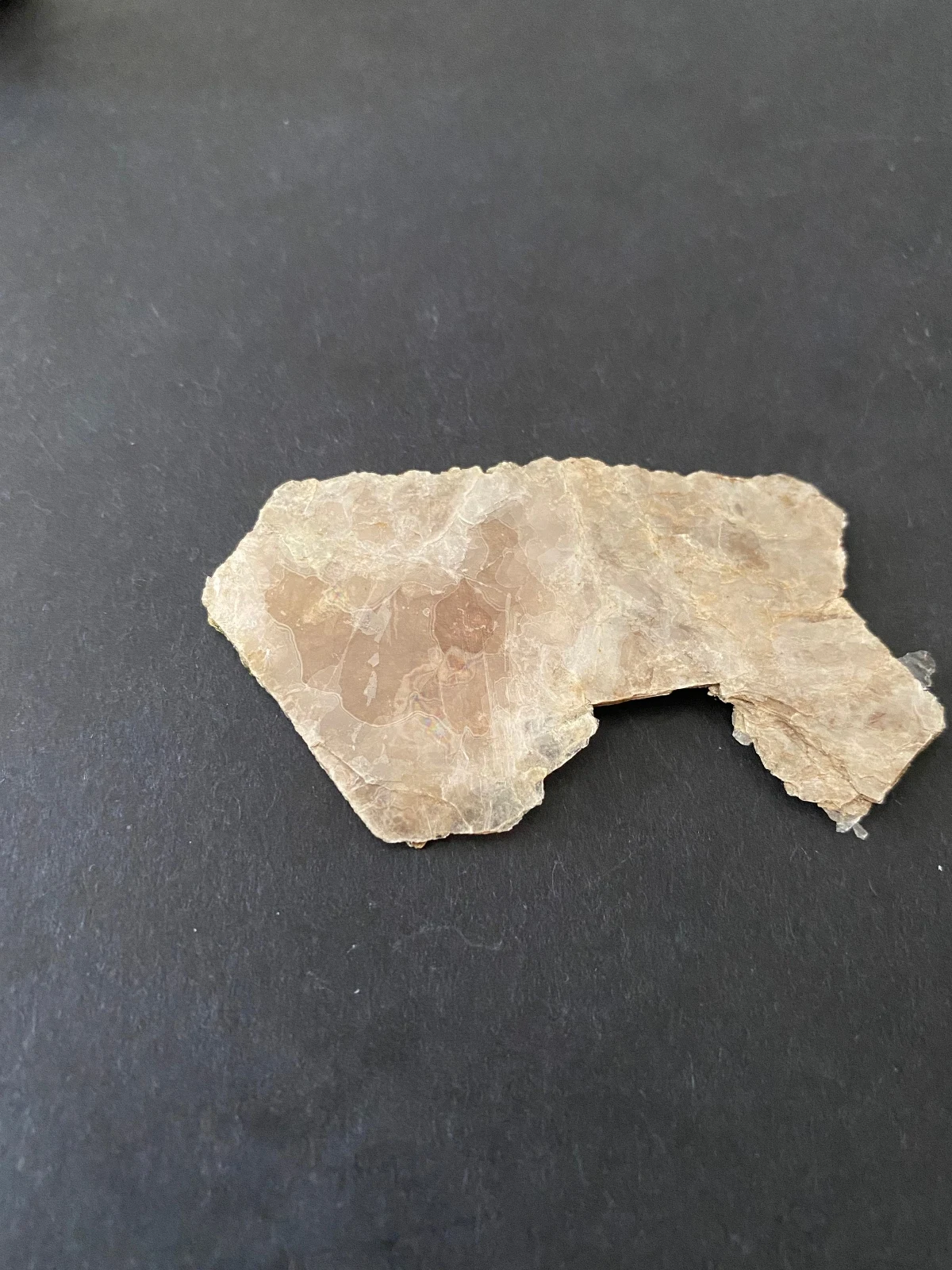
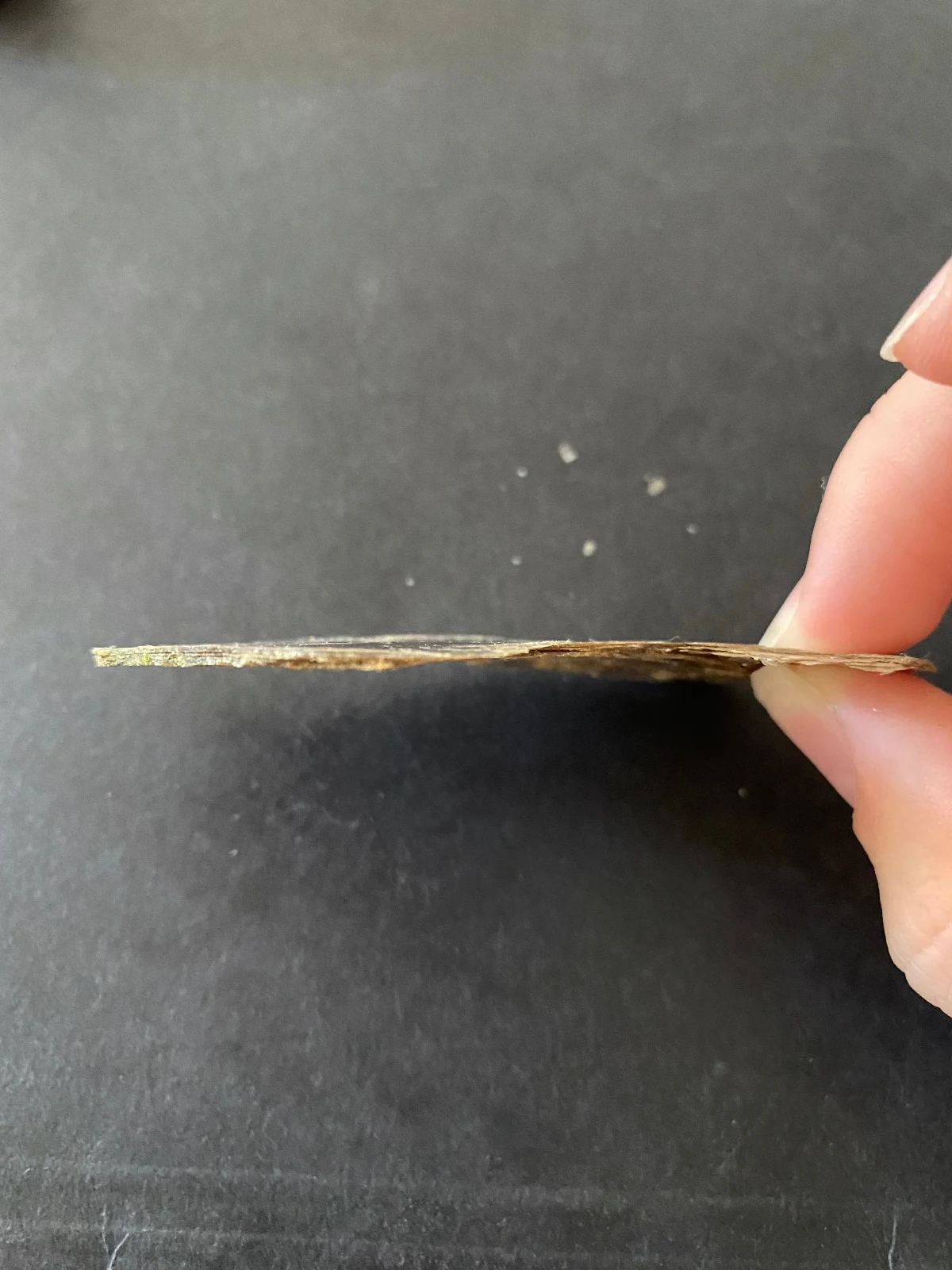

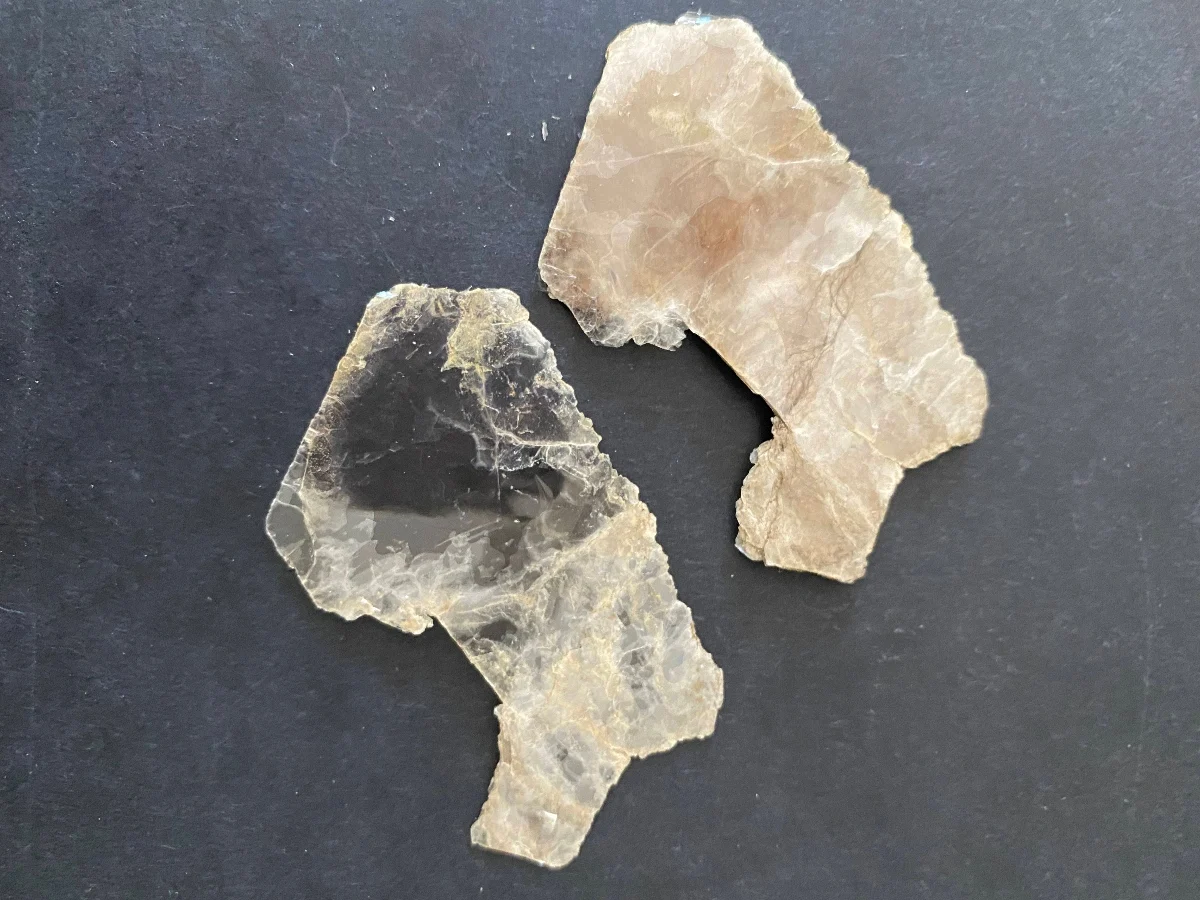
As a result of our experiment, we can conclude that muscovite cleavage is perfect in one direction – basal cleavage.
TIP: There are dozens of books dedicated to nature, geology, minerals, rocks, and gemstones. However, sometimes books don’t meet our expectations. Check out the best ones in the article below:
5 Best Books for Identifying Rocks & Minerals You Must Read
How to Identify Cleavage Planes
Cleavage planes are surfaces after breaking a mineral along its atomic weaknesses. Cleavage planes of minerals with perfect cleavage are even and highly reflective.
To identify cleavage planes, look for highly reflective surfaces on minerals. If cleavage is poor or indistinct, there can be small reflective surfaces on a massive background, but all of them will be parallel. Do not confuse crystal faces with cleavage planes. Crystal faces usually have striations.
Here is an example of feldspar with a reflective cleavage plane. Rotate your mineral to catch the reflection.
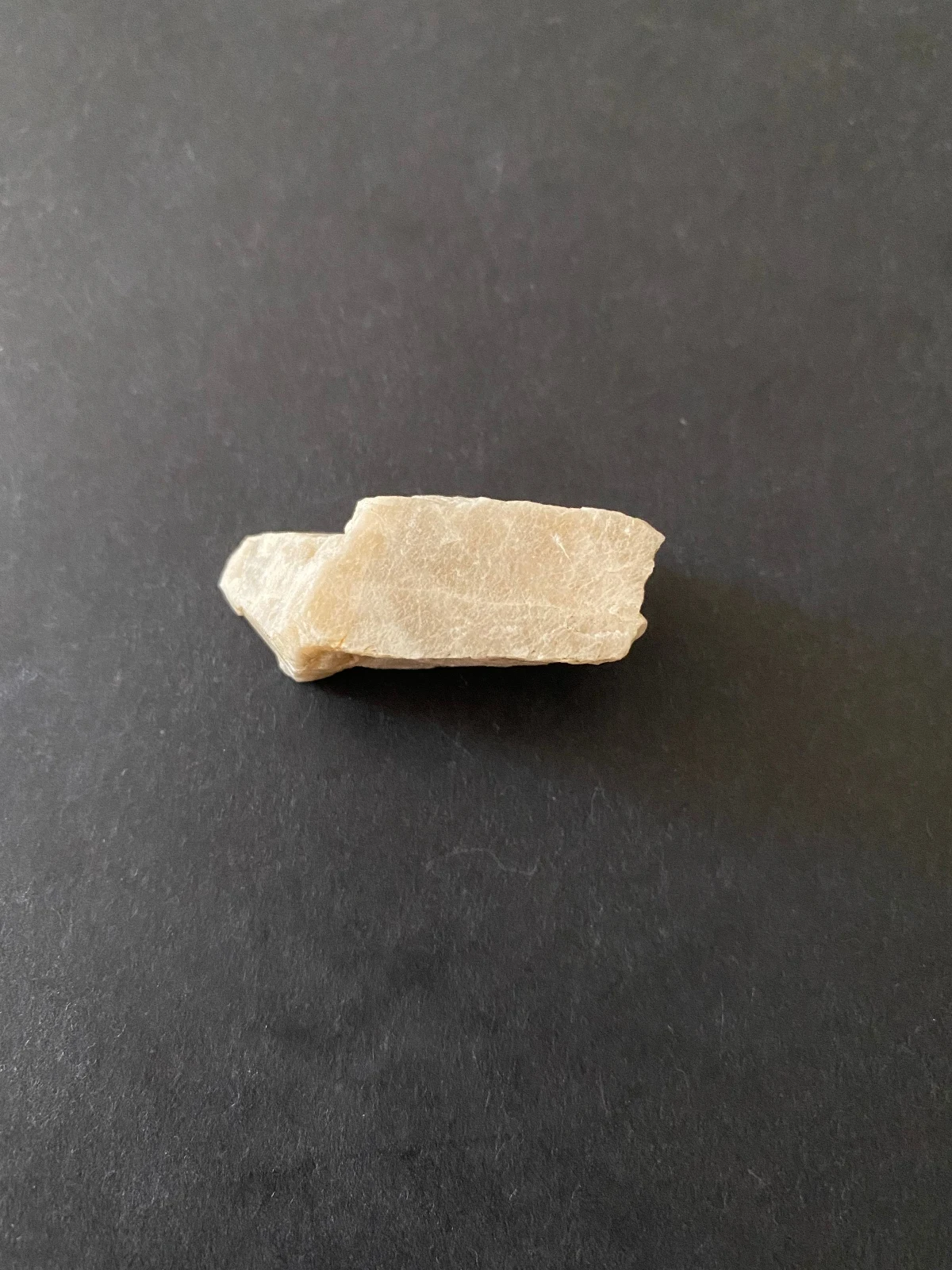
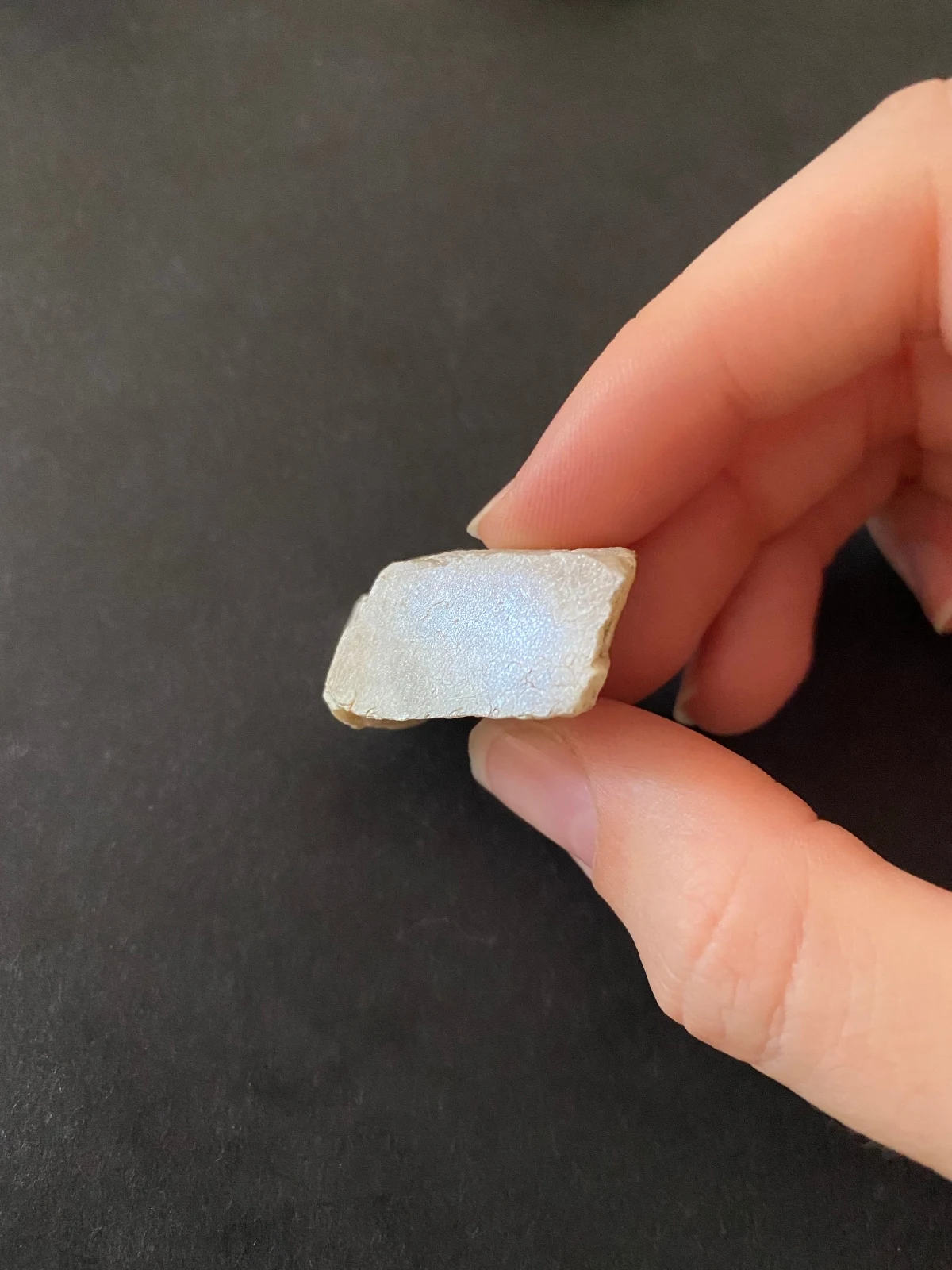
Cleavage planes can sometimes be confused with mineral faces as they both are even and reflective. Crystal faces are created during mineral growth, while cleavage only forms as mineral breaks.
One of the best methods to distinguish between them is striations on crystal faces. Cleavage planes lack these naturally occurring grooves. The best examples with the most apparent striations are quartz with horizontal striations and tourmalines with vertical ones.
Conclusion
Cleavage is an essential property of mineral identification. This is the property that reflects an inner structure of minerals. Cleavage planes occur along atomic weaknesses in the mineral structure.
Cleavage in minerals is usually described by three factors:
The quality of cleavage reflects how easily a mineral can be cleaved and the quality of the surface created during splitting.
- Perfect
- Good
- Poor
- Rough
- Indiscernible (Indistinct)
- None
Number of sides exhibiting cleavage stands for how many directions display cleavage planes.
- One direction
- Two directions
- Three directions
- All directions
Cleavage habit is used to describe the form created by cleavage planes.
- Basal cleavage
- Prismatic cleavage
- Cubic cleavage
- Rhombohedral (rhombic) cleavage
To describe the cleavage of minerals, combine three properties. For example, ‘perfect basal cleavage in one direction is the correct muscovite cleavage description.
Testing cleavage is extremely useful in the identification and differentiation of silicates. The most crucial examples are quartz and plagioclases. Whether they look similar in rocks, quartz has no cleavage, and plagioclases have perfect cleavage in two directions.
Another important example of cleavage test usefulness is the differentiation between amphiboles and pyroxenes, which have similar physical properties and are hardly distinguishable.
The angle between cleavage planes solves this problem. The angles between the prismatic cleavage planes for the pyroxenes are (88-92°) and for the amphiboles (56-124°). No need to measure angles precisely. It is enough to observe right angles for pyroxenes and 60° for amphiboles.
TIP: Mineral identification is an integral part of work for both mineral collectors and scientists. An approach to identifying minerals also varies for different types of stones and purposes. Find out the complete guide in the article below:
Easy Step-by-Step Mineral Identification (Expert Explains)
